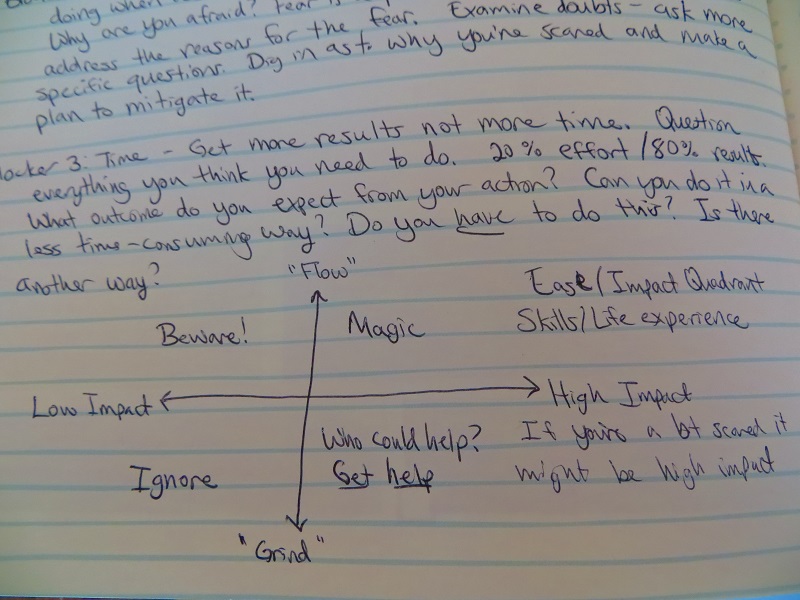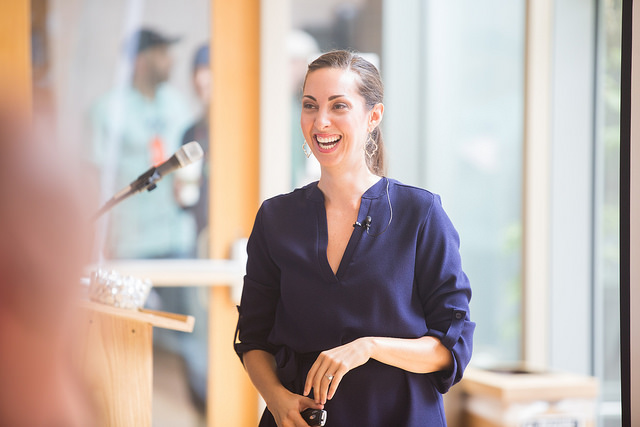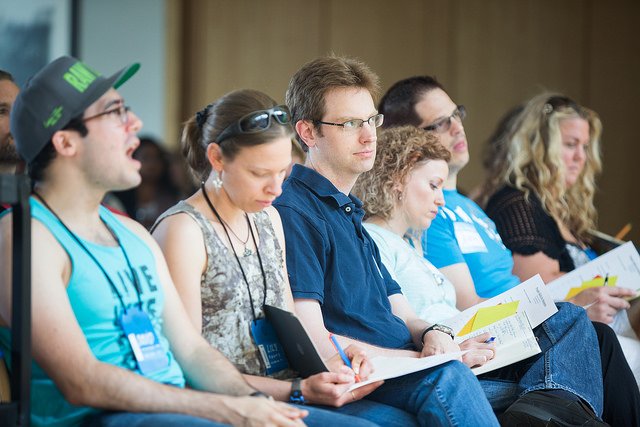Notes from World Domination Summit 2015: Part 4
Have you read my earlier WDS posts?
Click here to read Part 1 from July 9 and 10.
Click here to read Part 2 from July 11.
Click here to read Part 3 from July 12.
This is the fourth and final in my series of WDS notes. If you missed WDS, I hope you found this enjoyable! And if you were there, hopefully my notes brought back some good memories and added some new perspective.
We’d wrapped up the main stage presentations and closing party the night before, but on Monday, July 13, they offered another day of WDS Academies, so I signed up for the full experience!
How to Take Action After WDS: Pam Slim and Rob Young

I’ve definitely had the experience of going to a conference, coming up with some great ideas, and then being so overwhelmed that I didn’t really know where to start with all of the information I’d been exposed to. So when I saw this workshop, I signed up right away.
Pam and Rob pointed out that ideas don’t change the world; action does. Success = idea X action. Do rather than dream.
So, what stops us from taking action? They identified four blockers:
- Idea overwhelm. Either too many ideas, “blah” ideas, or no ideas at all. Don’t wait for the perfect idea. You discover better ideas as you act.
- Fear. Where is the fear? We all have fear connected with our idea somewhere. The antidote is definition. Why are you afraid? Fear is a protective force. Take steps to address the reasons for the fear. Examine doubts. Ask specific questions. Dig in as to why you’re scared and make a plan to mitigate it. Dancing with the fear is what we’re doing when we ship.
- Time. Get more results, not more time. Question everything you think you need to do. Remember, 20% of your effort yields 80% of your results. What outcome do you expect from each action? Can you do it in a less time-consuming way? Do you have to do this? Is there another way? Look at each activity through the Ease/Impact Quadrant:

- Inertia. Where do you even start? You need to plan…but don’t over plan. “Just enough” plan. Plans unblock inertia.
There are three levels:
CEO – The vision. That big thing you will do.
Manager – The “just enough” plan to get moving on your project.
Doer – The worker. If you know the task but not the steps to take, ask someone who has done it before!
You’ll need to wear all three hats, but not all at once! Which of these things comes most naturally to you? Where do you need the most work?
To help you decide which idea to work on, do these things:
- List out all your ideas—don’t evaluate, just list.
- Think about the different criteria to consider: What’s the strongest fit with your values? What’s the quickest path to money? What’s the most meaningful? What will make the biggest impact? Which is the easiest to execute? What’s most fun? Which is the most strategic? What’s most profitable? Select the top 3-5 criteria you feel are most important to consider.
- Create a matrix with your most important criteria down the side and your top ideas across the top. Give each idea a rating of 1 to 3 (least to most) for each criterion, then add the columns at the bottom. Which idea has the most points based on your most important criteria?
- Select your top idea. Describe it, and identify the fears you have about it.
- Put on your CEO Hat and write out your big vision for your idea.
- List out all the things you need to do to move your idea forward.
- Organize your ideas along the Ease/Impact Quadrant (see above).
- Create a plan for how you will carry out your idea for each of the next 4 quarters. Do the easy/high impact activities soonest. Eliminate the difficult/low impact activities. Think about where you could get help for the high impact/difficult activities.
- For the very first activity you need to do, break it down into small steps and list the three micro actions to take next.
The Six Repeatable Steps:
- Big picture
- Break it down
- Work out what matters
- Build it back up
- Get specific
- Make it easy and do it!
People Skills for Business: Vanessa Van Edwards

The last workshop of WDS had arrived, and I’d been looking forward to this particular Academy. I’ve been following Vanessa Van Edwards for well over a year and had taken a few of her online classes. She has a website called ScienceOfPeople.com and is an expert in the science of body language and people skills. Here are my notes:
People skills are the glue of business.
Physical pain and social pain are perceived the same way by the brain.
Design your unique brand of charisma.
Instead of the usual boring conversation starters, “Where are you from?” “What do you do?” etc., use more creative conversation starters. For example, “Is this a busy season for you?” “Any vacations coming up?”
Have a story toolbox. Weave in favorite stories with people who aren’t too interested in you. Put “hooks” in the stories. What are your favorite stories to tell?
Save conversation-worthy articles (the Pocket app is great for this).

10 People Principles:
- Capture that first spark. First impressions matter! People only take a second to make up their mind about you and it’s very difficult to change!
- Always thrive. Figure out which social environments you thrive in, which ones you dread and which ones are neutral. Be sure to “fuel up” before attending any “survive” event!
- Build trust. We judge on charisma, credibility and intelligence. In order to convey the best impression of yourself, keep your hands visible and expressive (above desk, out of pockets). Keep your hands visible when the other person talks. Consider adding videos to your website, and keep your hands visible in the video. Handshakes should be firm, 1-3 pumps, and dry (if your palms are sweaty dry them off first—some people carry a tissue in their pocket for this, or use your clothes).
- Trigger dopamine. People love to talk about themselves. Let them impress you. Keep the conversation going by saying, “Yes, and…” and add to what they have said. Some potential conversation starters: “What personal passion projects are you working on?” “Anything exciting happen today?” “Any trips coming up?” What’s the first question you ask at a networking or client event? Can you come up with a better one?
- Connect purposefully. We tend to use one of three gazing styles when we look at someone. Power gazing is looking at the other person between the eyes and the forehead. Social gazing is looking at the other person’s eyes and mouth. Intimate gazing is looking from the other person’s eyes all the way down to their sternum and back up. The type of gaze you use will affect how you are perceived. Social gazing kills negotiation. What’s your default gaze?
- Be memorable/vulnerable. Ask people for advice. Think about what you need help with, and what you’ve done already on your own. Who can help you? Asking for advice allows other people to talk about themselves (which makes them feel better) and shows your vulnerability, which makes you more memorable to them.
- Decode hidden emotions. Learn to read people’s facial micro-expressions to detect fear (raised eyebrows, open mouth), anger (verticle lines on forehead, hard eyelids), happiness (crow’s feet next to eyes, cheeks raised), contempt (one-sided mouth raise, narrowed eyes), disgust (nose crinkled, upper row of teeth visible), etc. Respond appropriately to these emotions so that they feel understood. Practice at ScienceOfPeople.com/practice!
- Be the highlight. Always start on a high (positive) note with people (e.g., “Nice weather!”), not on a negative. Be a raver/super introducer at your next event. When you introduce people to each other really talk them up (in a genuine way—don’t be fake).
- Honor personality. Use the “platinum rule”: Treat others as they would treat themselves. People will want to be treated differently depending on whether they are introverts or extroverts, focused or easy-going, explorers or preservers, worriers or calm, challengers or agreeable. If you want to attract a particular personality type to your business, write your website to appeal to your ideal customer. Get a free app at ScienceOfPeople.com/personality!
- Be the element of surprise. Find ways to add surprise to your business interactions. Some ideas: add quotes or funny jokes to your e-mail signature; add quotes or questions to your name tag at networking events; include surprise features/bonuses to your products; have surprise specials; celebrate client anniversaries; send occasional gifts to clients; organize fun/unique meeting locations; find ways to add surprise to business cards, marketing materials, website, etc.
If you want to learn more about body language or people skills of any kind, whether for business or for your personal life, I highly recommend Vanessa Van Edwards. She really knows her stuff and has several different courses available online!
Goodbye, WDS!
And after a Q&A session with Vanessa, just like that, it was over. I took my lunch—which I hadn’t had a chance to eat between the two Academies—and sat out on the steps in the shade outside the building, watching people go by as I ate. Another attendee came and joined me after awhile and we chatted until his bus came.
I had a great time and part of me wanted WDS to keep on going, but the other part of me was getting pretty “peopled out”—being around large groups of people for 5 days straight can be tiring when you’re an introvert. Especially with the big parties thrown in.
All in all, I learned some new things, recharged on inspiration, and made some great connections. I’m so glad I went, and I hope to come back to WDS in the future!
Enter your name and email to receive my newsletter and stay up to date!
We hate spam as much as you. Your email is safe with us.

